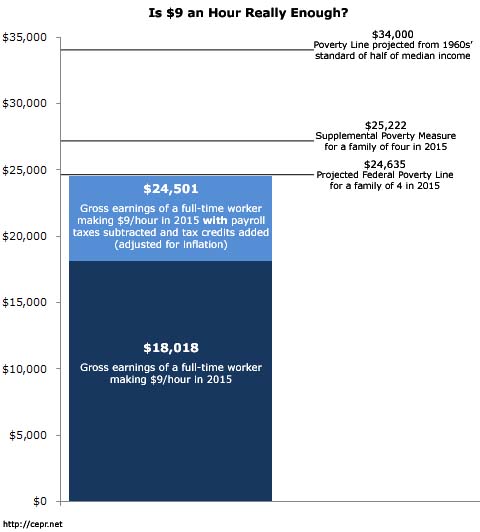February 14, 2013
According to the White House, the President’s proposal to increase the minimum wage to $9 an hour by the end of 2015 will ensure that “no one who works fulltime should have to raise their family in poverty.”
But is a $9 minimum wage sufficient to meet this goal? Not necessarily, even if we use the antiquated official poverty threshold, and especially not if we use a modern threshold that comes a little bit closer to what families need to make ends meet at a basic level in today’s economy.
First, let’s look at where $9 an hour gets a family of four using the antiquated official threshold. Using the same assumptions as the White House, a family of four supported by a full-time worker earning $9 an hour would have gross earnings of $18,018 in 2015. This would put them about $6,600 below the projected 2015 poverty line of $24,635. (To get the projected poverty line, I adjust the Census official poverty threshold using CBO’s most recent inflation projections.)
If we subtract payroll taxes and add in the Earned Income Tax Credit and Child Tax Credit, their net income would come to $24,501—99 percent of the official poverty line (here, again, I adjust the value of the EITC and CTC, which are indexed to inflation, using CBO’s projection). This calculation is favorable to the Administration because it assumes that the $9 minimum will be in place for all of 2015 (the White House fact sheet says only that it will be in place by “end of 2015”).
Second, since I can’t imagine anyone in the Obama White House will speak out in favor of the antiquated official measure as an accurate measure of poverty today, let’s use the Supplemental Poverty Measure, a measure that the Administration has sought funding for in previous budgets.
In 2011, the Supplemental Poverty Measure for a family of four was $25,222 (this is for renters, for mortgage holder it was slightly higher). Adjusting this threshold for inflation produces a threshold of $27,194, which means that our family of four with net income of $24,501 would fall short of the poverty line by nearly $2,700. Instead of 99 percent of the poverty line, they’d be at 90 percent.
Finally, it’s worth remembering that either poverty line is an extremely low bar. When it was adopted in the 1960s, the poverty line was equal to about half of median income. If it had kept pace since then with mainstream living standards, it would be around $34,000 for a family of four. And the vast majority of Americans say that working families of four need at least $40,000 to make ends meet in their communities. If we really want to ensure that “hard work leads to a decent living”, we need to set the floor closer to where the public believes it actually is.







